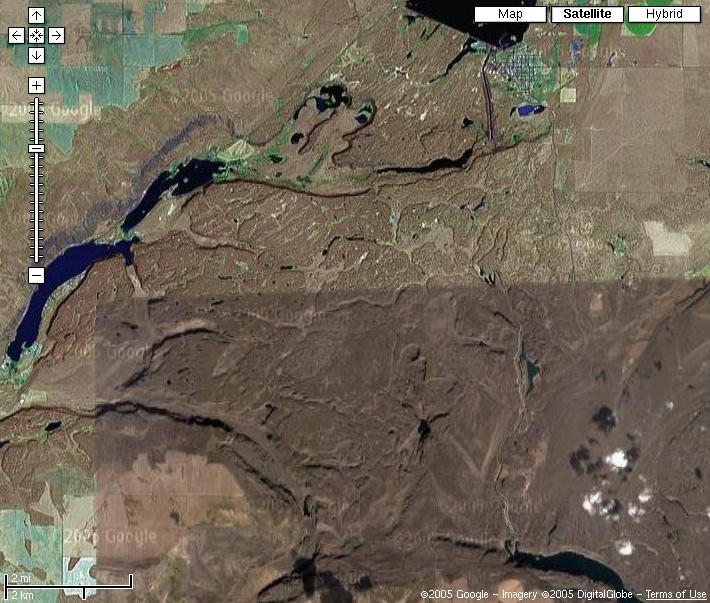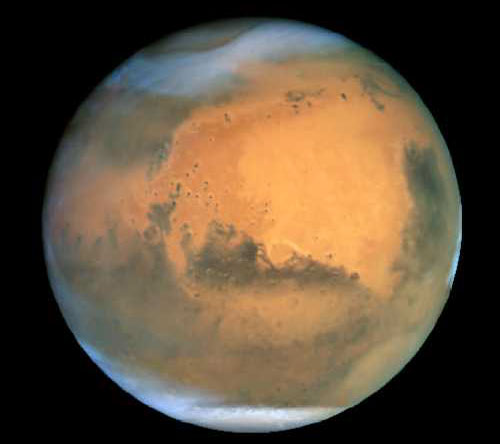 Quick Facts:
Quick Facts:
 Quick Facts:
Quick Facts:
Mars is relatively small, having only about 10% the mass of the Earth
Mars has an atmosphere made up mostly of Carbon Dioxide but its pressure is only 1% of the Earth's atmospheric pressure. Thus Mars has 10,000 times less Carbon Dioxide in its atmosphere than Venus
Mars is tilted on its axis by 25 degrees, very similar to the Earth and hence Mars has seasonal variations
These seasonal variations cause frozen carbon dioxide to sublime from the Polar Caps thus giving Mars a seasonal atmospheric pressure
Surface featurs of Mars are continually augmented and eroded by Wind and periodic dust storms.
Humans have always had a fascination with Mars and have pondered. mostly in a science
fiction manner, the possibility of their being life on Mars. Visual observations of
Mars made by astronomers through telescopes in the period 1880-1920 fueled speculation
for of a civlization on Mars. The Italian astronomy Schiaparelli first made detail maps
of the surface of Mars from visual inspection through a telescope in 1877. Over the
next decade he worked to refine these maps, some of which are reproduced below:



As a result, this has fueled much speculation about Life On Mars. Here are a few highlights:
With all this is a backdrop, curiousity about Mars began to drive several space craft missions:
Early Spacecraft Encounters with Mars:
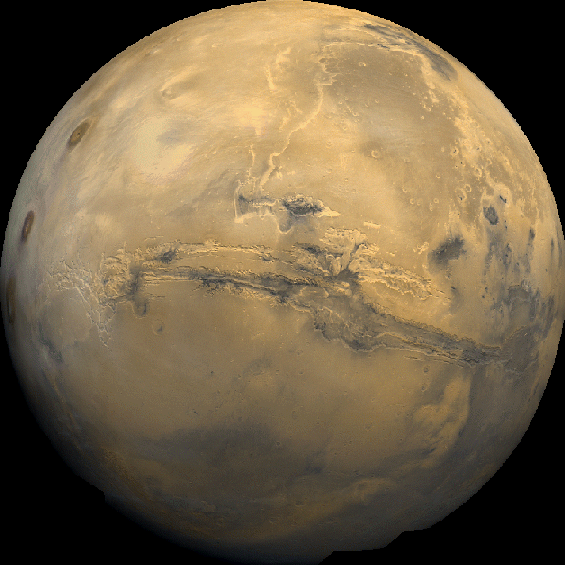
Although Valles Marineris originated as a tectonic structure, it has been modified by other processes.
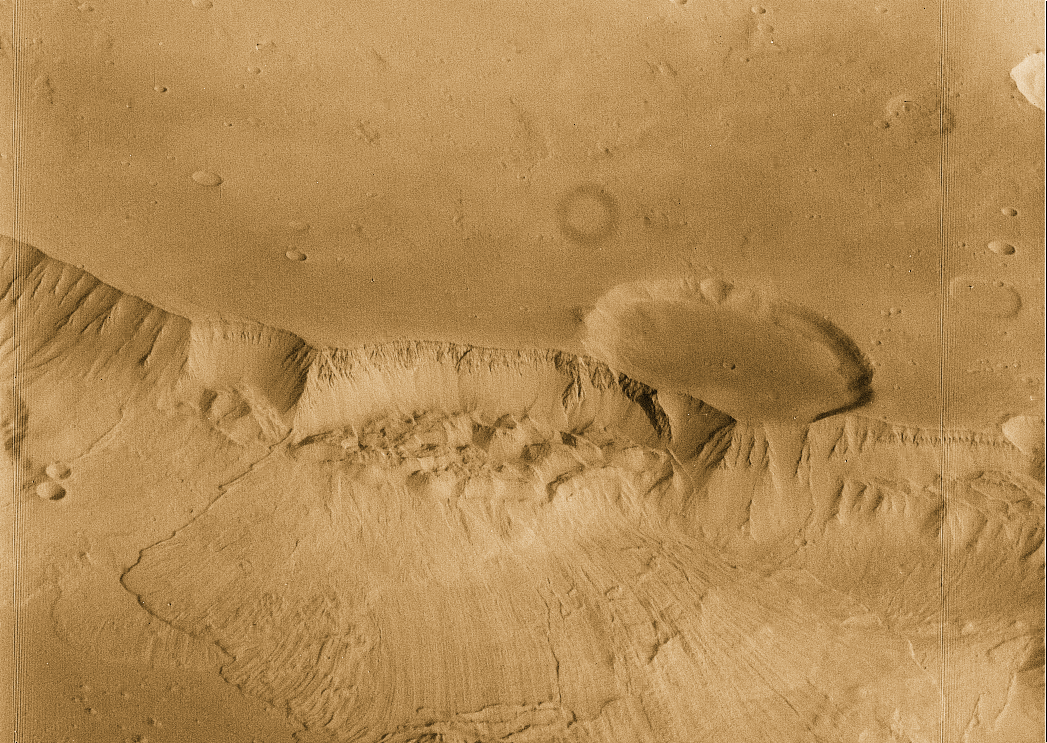
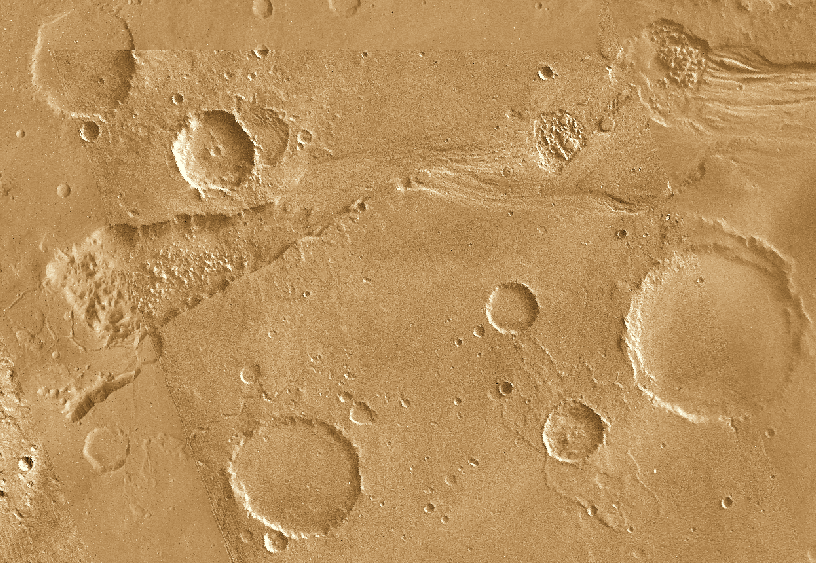
This image of the head of Ravi Vallis shows a 300-kilometer long portion of a channel. Like many other channels that empty into the northern plains of Mars, Ravi Vallis originates in a region of collapsed and disrupted ("chaotic") terrain within the planet's older, cratered highlands. Structures in these channels indicate that they were carved by liquid water moving at high flow rates. The abrupt beginning of the channel, with no apparent tributaries, suggests that the water was released under great pressure from beneath a confining layer of frozen ground. As this water was released and flowed away, the overlying surface collapsed, producing the disruption and subsidence shown here.
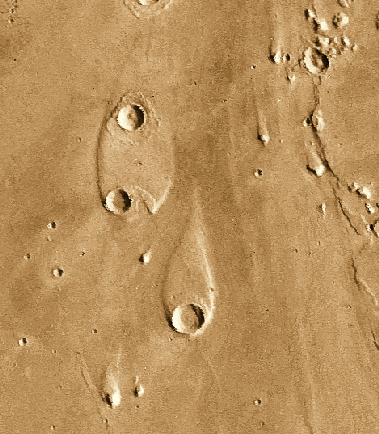 The water that carved the channels to the north and east of the Valles Marineris canyon system had tremendous erosive power. One consequence of this erosion was the formation of streamlined islands where the water encountered obstacles along its path. This image shows two streamlined islands that formed as the water was diverted by two 8-10 kilometer diameter craters lying near the mouth of Ares Vallis in Chryse Planitia. The water flowed from south to north (bottom to top of the image). The height of the scarp surrounding the upper island is about 400 meters, while the scarp surrounding the southern island is about 600 meters high. There is a great deal of evidence of the existence of liquid water on Mars, at least in the far past. A secondary atmosphere for all terrestrial worlds is rich in CO2, H2O and SO2. On Earth, the temperature is just right for H2O to rain out and form oceans. On Venus, the temperature is too hot and H2O stays as a vapor to be destroyed by photodisintegration. On Mars, it is too cold for liquid water. All the H2O is locked up in permafrost under the soil and subsurface ice reservoirs. Notice that most of the water flow features are near the base of old volcanoes or impact craters. These early events heated the subsurface ice to produce a short-lived flow of liquid H2O.
The water that carved the channels to the north and east of the Valles Marineris canyon system had tremendous erosive power. One consequence of this erosion was the formation of streamlined islands where the water encountered obstacles along its path. This image shows two streamlined islands that formed as the water was diverted by two 8-10 kilometer diameter craters lying near the mouth of Ares Vallis in Chryse Planitia. The water flowed from south to north (bottom to top of the image). The height of the scarp surrounding the upper island is about 400 meters, while the scarp surrounding the southern island is about 600 meters high. There is a great deal of evidence of the existence of liquid water on Mars, at least in the far past. A secondary atmosphere for all terrestrial worlds is rich in CO2, H2O and SO2. On Earth, the temperature is just right for H2O to rain out and form oceans. On Venus, the temperature is too hot and H2O stays as a vapor to be destroyed by photodisintegration. On Mars, it is too cold for liquid water. All the H2O is locked up in permafrost under the soil and subsurface ice reservoirs. Notice that most of the water flow features are near the base of old volcanoes or impact craters. These early events heated the subsurface ice to produce a short-lived flow of liquid H2O.
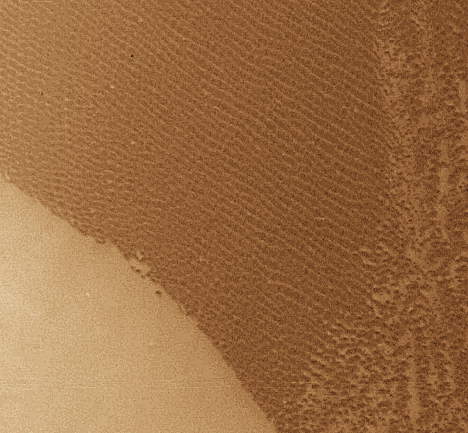 There is also much evidence for wind features on Mars in the
form of sand dunes and wind eroded craters. The current atmospheric pressure on Mars is low,
about 1% that of the Earth's but that is still sufficient to generate wind and substanial air
borne dust. As a result, Mars has relatively few impact craters visible on its surface as
most of them have been aroded away. Ultimately the sand blasting nature of the winds,
coupled with very low temperatures at night limit the operational lifetime of any equipment
that we place on Mars for surface monitoring and measurements.
There is also much evidence for wind features on Mars in the
form of sand dunes and wind eroded craters. The current atmospheric pressure on Mars is low,
about 1% that of the Earth's but that is still sufficient to generate wind and substanial air
borne dust. As a result, Mars has relatively few impact craters visible on its surface as
most of them have been aroded away. Ultimately the sand blasting nature of the winds,
coupled with very low temperatures at night limit the operational lifetime of any equipment
that we place on Mars for surface monitoring and measurements.
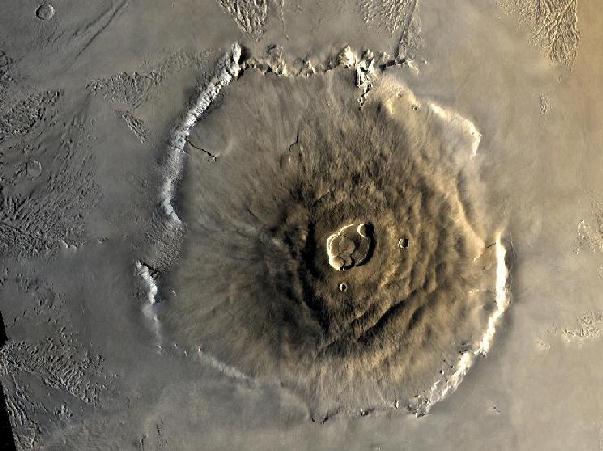 There are very large shield volcanoes on Mars. The Tharsis and Elysium are rich in old cone volcanoes, averaging over 500 km across and 25 km high. These are ``hotspot'' volcanoes like the Hawaii Islands. The extreme size is due to the fact that there is no tectonic plate motion on Mars and the lower gravitational field strength of Mars allows
volcanic ejecta to reach higher distances above the surface.
There are very large shield volcanoes on Mars. The Tharsis and Elysium are rich in old cone volcanoes, averaging over 500 km across and 25 km high. These are ``hotspot'' volcanoes like the Hawaii Islands. The extreme size is due to the fact that there is no tectonic plate motion on Mars and the lower gravitational field strength of Mars allows
volcanic ejecta to reach higher distances above the surface.
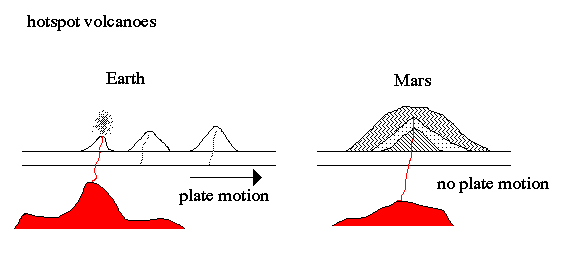
In addition to these features, Mars shows examples of chaotic terrain in the form of highlands
and broken hills. These are probably old tectonic regions. There are also numerous canyons
and long fractured regions. These may be mostly tectonic in origin as well.
Mars is another example of a secondary atmosphere from outgassing (therefore, we know that Mars had an early epoch of tectonic activity). However, unlike the Earth or Venus, the atmosphere is very thin, about 1% the mass of Earth's atmosphere. Its composition is 95% CO2, 3% N2, 2% Ar and less than 1% O2. A high noble gas content implies that Mar's atmosphere was much thicker in the past (noble gases do not react with other elements and are heavy enough to stay within the gravitational field of Mars). The climate on Mars is very desert-like due to its thin atmosphere. There is too little mass in the atmosphere to hold in heat so the warmest daytime temperatures are around 50 degrees F, but the nighttime temperatures are -170 degrees F. Other weather features are massive dust storms and occasional CO2 fog in the canyons.
Summary of Likely Surface Geological Evolution on Mars:
